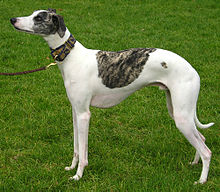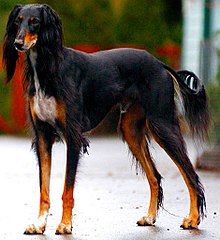Sighthound

Sighthounds, also called gazehounds, are hounds that primarily hunt by speed and sight, instead of by scent and endurance, as scent hounds do.
Appearance

These dogs specialize in pursuing prey, keeping it in sight, and overpowering it by their great speed and agility. They must be able to quickly detect motion, so they have keen vision. Sighthounds must be able to capture fast, agile prey such as deer and hare, so they have a very flexible back and long legs for a long stride, a deep chest to support an unusually (compared to other dogs) large heart, very efficient lungs for both anaerobic and aerobic sprints, and a lean, wiry body to keep their weight at a minimum.
The typical sighthound also has a light, lean head, which is referred to as being dolichocephalic in its proportions. This shape can create the illusion that their heads are longer than usual. Dolichocephaly is actually a characteristic of wolves and other wild carnivores, and is related to the need for stereoscopic vision in active hunting. For reasons not yet understood, most domesticated animals including dogs (other than the sighthounds) have become brachycephalic—short-headed—and have partially lost this aspect of their field of vision (see cephalic index).
History

Sighthounds such as the Saluki may have existed for at least 5,000 years, with the earliest known sighthounds appearing in Eurasia. The earliest description of a sighthound in European recorded history comes from Arrian's Cynegeticus, of the 2nd century AD. Although today most sighthounds are kept primarily as pets, they have been bred for thousands of years to detect movement, chase, capture, and kill prey primarily by speed. They thrive on physical activity. Some have mellow personalities, others are watchful or even hostile towards strangers, but the instinct to chase running animals remains strong.
Apart from coursing, open-field coursing, and hunting, various dog sports are practiced with purebred sighthounds, and sometimes with Lurchers and Longdogs. Such sports include racing, lure coursing, and other events.
List of sighthounds
This list is incomplete; you can help by adding missing items. |
- Afghan Hound
- American Staghound
- Azawakh
- Borzoi
- Chart Polski (Polish Greyhound)
- Chippiparai
- Galgo Español (Spanish Greyhound)
- Greyhound
- Hortaya Borzaya (Chortaj)
- Irish Wolfhound
- Italian Greyhound
- Kangaroo Dog
- Kanni
- Khalag Tazi
- Longdog
- Lurcher
- Magyar Agar (Hungarian Greyhound)
- Mudhol Hound
- Rajapalayam
- Rampur Greyhound
- Saluki
- Scottish Deerhound
- Sloughi
- Taigan
- Tasy
- Whippet
Debate around breed inclusion
There has been considerable debate[1] in many quarters about what breeds are considered to be sighthounds. This is partially due to the fact that most Anglophone kennel clubs do not have a "Sighthound" group per se, where they are included in the larger "Hound" group. Nonetheless, the Old World (FCI) understanding of the sighthound is quite clear and well documented: sighthounds are gräoid (greyhound) shaped dogs, which owe their specific build to their recorded function of speed hunting.
While this debate may appear to simply be a matter of semantics, it is of deeper importance when categorizing breeds through a thorough understanding of their true history and function. The original and documented use of a breed is paramount in deciding its category as a hound, sighthound, working dog, toy breed, etc. It is also of practical concern where the sport of lure coursing is concerned, which is typically only open to breeds which may be considered to be sighthounds by the host breed clubs (in North America, particularly the USA) or the organizations that govern the sport (elsewhere).
For instance, both the Canadian Kennel Club and the American Sighthound Field Association consider the Basenji to be eligible for the purpose of lure coursing even though the Fédération Cynologique Internationale does not.
See also
References
Further reading
- Almirall, Leon V. Canines and Coyotes. Caldwell, Id.: The Caxton Printers, Ltd., 1941.
- Belkin, Dan. "The Functional Saluki: Lessons from the Coursing Field". Field Advisory News, November/December 1993.
- Brown, Curtis. Dog Locomotion and Gait Analysis. Wheat Ridge, Colo.: Hoflin Publishing, 1986.
- Burnham, Pat Gail. "Rhodesian Ridgebacks, and the Question of What is a Sighthound?". Field Advisory News, March/April 1992.
- Como, Denise. Sighthounds Afield: The Complete Guide to Sighthound Breeds & Amateur Performance Events (With a Comprehensive Chapter on Adopted Ex-Racing Greyhounds). Bloomington, Ind.: AuthorHouse, 2004. ISBN 1418438227.
- Copold, Steve. The Complete Book of Coursing: Hounds, Hares & Other Creatures, rev. & expanded 2nd ed. Wheat Ridge, Colo.: Hoflin Publishing, 1996.
- Copold, Steve. Hounds, Hares & Other Creatures: The Complete Book of Coursing (1st ed.). Arvada, Colo.: D. R. Hoflin, 1977 (1996).
- Cunliffe, Juliette. Popular Sight Hounds. London: Popular Dogs Publishing Co. Ltd., 1992. ISBN 0091750253.
- Grant-Rennick, Richard (ed.). Coursing: The Pursuit of Game with Gazehounds. Saul, Gloucestershire: The Standfast Sporting Library, 1977. ISBN 0950214892.
- Hawkins, Richard. "What Is A Sighthound". Dogs In Canada, April 2006.
- Hawkins, Richard. "Sighthound Identity". The Performance Sighthound Journal, July-September 2007
- Miller, Constance O. Gazehounds: The Search For Truth. Wheat Ridge, Colo.: Hoflin Publishing, 1988.
- Phillips, A.A., and M.M. Willcock, (eds.). Xenophon & Arrian On Hunting with Hounds. Oxford: Aris & Phillips, 1999. ISBN 0856687065.
- Recum, Andreas F. von, Hunting With Hounds in North America. Gretna: Pelican Publishing Co. 2002. ISBN 1-58980-043-5
- Russell, Joanna. All about Gazehounds. London: Pelham, 1976. ISBN 0720709261.
- Salmon, M. H. ("Dutch"). Gazehounds & Coursing. St. Cloud, Minn.: North Star Press, 1977. ISBN 0878390243.
- Salmon, M. H. ("Dutch"). Gazehounds & Coursing: The History, Art, and Sport of Hunting with Sighthounds, Rev. and expanded 2nd ed. Silver City, N.M.: High-Lonesome Books, 1999. ISBN 0944383491.
